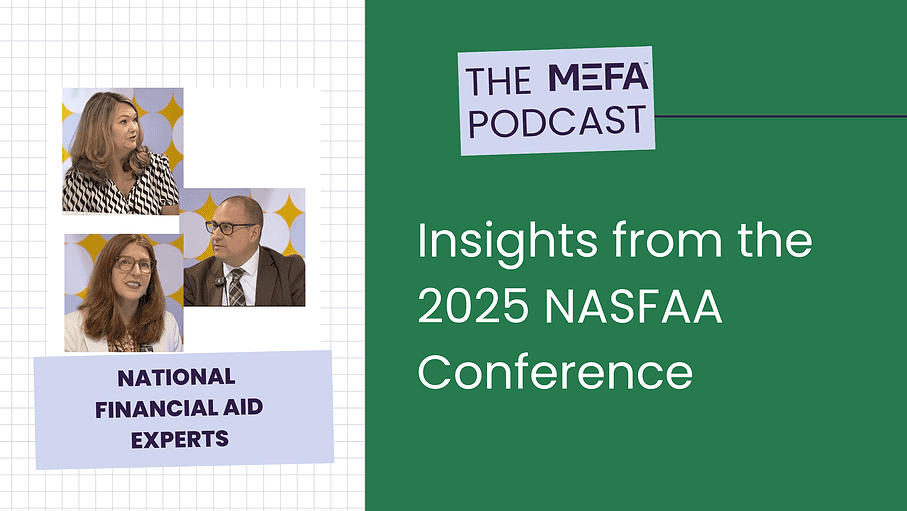Resources Mentioned in this Episode
Jonathan Hughes: [00:00:00] Hi everyone, and welcome to this special episode of the MEFA Podcast filmed on location in Anaheim, California at the NASFAA Conference over the summer. Let me explain what this is. NASFAA is the National Association of Student Financial Aid Administrators, and this is their annual conference. And MEFA was there along with many other lenders as an exhibitor.
And since we were there, we thought, what better time to meet some financial aid professionals, get to know their thoughts on what families should know about their own financial aid offices, where they see higher education going in the future, their own personal views and stories and much more. So I can’t wait for you to meet them.
They were all very generous with their time and what they had to say was really illuminating. So I will be back after the show To wrap things up, [00:01:00] now, let’s meet our guests.
Ken Ferriera: So I’m Ken Ferriera. I’m the Assistant Vice President for Student Financial Services at Suffolk University in Boston. I’ve been there since December.
So I think it’s coming up on seven months. Congratulations. And it’s been lots of fun. Thank you. I have a great team and work with great colleagues. And Suffolk is a really special place. I really like the students. And so it’s been a really. Positive change. I’ve been in financial aid professionally for 27 years.
This is my 27th year. Prior to that, I was a work study student, and so I joke that I’ve been in a financial aid office my entire adult life. But I can’t think of anything else that I’d rather do than, help students and. And work in higher ed.
Celena Tulloss: I’m Celena Tulloss. I’m the Assistant Vice President for Enrollment Management and Executive Director of Financial Aid and Scholarships at Auburn University. Auburn, Alabama. I have been there just over a year. Oh. But I have been in the financial aid world gosh, going on 25 years now. I got my start out of college. I wasn’t sure what I wanted to do. I thought, okay, I’m going to take a [00:02:00] year. I’m going to work and I’m going to take my LSAT and I’m going to go to law school. And I started working in this community action agency that did like third party scholarship programs and I just found my niche.
Beth Maglione: I’m Beth Maglione. I am Executive Vice president of NASFAA. I just got finished with a stint as interim president and CEO while we were doing our presidential search. So that was an exciting year for me. And I’ve been with NASFAA a lot of years.
Jonathan Hughes: And so where were you before NASFAA then?
Beth Maglione: So my background is as a communicator. So I was a reporter editor and I did some of that for newspapers, but I also did that for NASFAA. So we have a whole communications arm. And over the years I’ve just ended up. Managing or overseeing basically every functional area at NASFAA. Okay. And certainly during the last year oversight of the whole organization.
Celena Tulloss: Education was always very important in my family. I’m originally from Appalachia, small town eastern Kentucky. My father was [00:03:00] one of 13 children that grew up on a farm. Every cliche that you could say about walking a mile to school and a one room school and what you would think of, the mountains. That’s where my family is from. And so my dad was the first in his family to attend college. He graduated high school at 16 and changed his birth certificate so that he could join the army.
Because he heard if he got the GI bill that it would pay for college. And so he went to the Army. Four years, got out, went to Berea College in Kentucky, which is a work college where they actually give you a job that you work on campus and that’s what pays your tuition. He was a barber and worked in the dairy.
And that did his way through Berea in that way, and then used his GI bill and scholarships to go to medical school at the University of Kentucky. So I grew up with a very different life than what my father had lived because of the power of education. He came from working on a farm. 13 children. Two. I grew up having a father who was a physician. My mother was a nurse and so I grew up in a [00:04:00] household that really said, there’s power in education.
Ken Ferriera: I wasn’t first gen, but my mom was an adult student. She went back to school at , at 32. Single mom. Didn’t graduate until she was 37. Yeah. It took her five years. And I followed in her footsteps, but I know what she did changed the trajectory of our family.
Jonathan Hughes: And is that why, financial aid as a noble sort of endeavor? I do.
Ken Ferriera: Yeah, I do. And it’s a noble endeavor because if anything, it helps level the playing field of who can attend and who can’t.
Jonathan Hughes: Do you think that people make. Or look at college as a dollars and cents for turn on investment type of thing? Or is it more of a deeper or more nebulous enterprise?
Ken Ferriera: I think that, over the span of my career that college and education has become very transactional. And so that the mindset is that it is transactional. And what I think happens over time is. That [00:05:00] the life changing experience that college is for so many of us. That happens in the process of experiencing what they see as a transaction. And so that later on, that transactional component fades.
And it’s not so much of a transaction as it is, as an experience, and that hindsight is always 20/20. And that they see that this was so much more. Than a dollars and cents experience that this was life changing.
Beth Maglione: I think we’ve gotten away from the idea that higher education is a value to our entire society. I think it’s more I think the rhetoric is more focused on the individual who may or may not benefit from a specific degree.
We know, there’s many success stories, but there are stories of people who have. Fallen out of the system and gained debt during that process. And those are, that’s a problem that we as a higher education industry do need to continue to tackle. But yeah, even the idea that an educated populace leads to a more [00:06:00] strong democracy.
I mean that there’s some high level concepts that I think have just been lost in the idea that, you trade a degree for income, yeah. That, that this is something that you get just so you can increase your pay. I think there’s more to it than that.
Jonathan Hughes: What do you wish that parents and families and students knew about the financial aid office and about financial aid? That they don’t necessarily?
Beth Maglione: I think one thing that our members would probably wish that families knew is that. Year over year financial aid is not a one and done. You don’t submit at the beginning and then it does change. Year over year what you might be eligible for, either from the school or through federal aid programs.
So this is an ongoing process that has to be readjusted every year. And an ongoing conversation with the financial aid office is really necessary. Yeah. So that you don’t make the. Inadvertent assumptions about what kind of aide you might be getting year over year. And then find yourself in a dire situation with your finances.
Celena Tulloss: I think understanding that the [00:07:00] FAFSA is the gateway and it’s not just the gateway to the Pell Grant program. I think a lot of more affluent families just think, okay, that’s, it’s merit scholarships, that’s all that’s going to be available to me. I’m not going to take the time to do the FAFSA. I think there’s still some.
Some feeling of that the FAFSA is this long, arduous process and it’s so hard, like people don’t understand for those that it works well for now, under simplification, it really does work well. It really is faster. I know on my campus that is a message that I try to get out again and again. We have a large number of our donor scholarships.
Over half of our donors scholarships have need as a criteria or a preference in those scholarships. And so you can be determined to have need. Even if you’re not super low income, even if you’re not qualifying for the Pell Grant. So it’s worth your time to take the time to go and do the FAFSA. The other piece I think is for the lower income families and those who understand they need to do the FAFSA it’s [00:08:00] seeing the bigger picture of the full cost of attendance.
And knowing how to comparison shop. I think the College Cost Transparency Initiative is doing some good things to try to make sure that Financial Aid award offers are similar so that students can more easily compare schools.
Jonathan Hughes: Okay. Hold on. Let me just explain what the College Cost Transparency Initiative is.
Historically, colleges have designed their own financial aid offers, and there’s not been necessarily any uniformity among them. So it makes it very difficult sometimes for students and families to compare and make an informed decision. The College Cost Transparency Initiative aims to change that by standardizing award letters and encouraging colleges to adopt those standardized award letters so that parents and students can have an easier time comparing.
Okay, now back to the show.
Celena Tulloss: Throughout my career, I’m always surprised at the number of [00:09:00] families who apply to an institution. They’re admitted, they get all the way to orientation before they figure out what it’s actually going to cost.
Ken Ferriera: Financial aid is about people and relationships, and if there’s anything that I try to convey to families, students, parents, the people that I work with, the people that are in my network is that. Financial aid professionals are largely in the business of helping people. And so you want that connection. You want that human connection, whether you are an undergraduate, a graduate, postgraduate, whatever the case may be. We are approachable work with us. There isn’t some giant mahogany desk that I sit behind in the Christmas story with Ebenezer Scrooge counting out these gold coins that is. Further from the truth. Yeah. If anything, I’m trying to spread extremely limited resources. As fairly and equitably as possible to help as many people as I can.
Jonathan Hughes: [00:10:00] How do you convince families and students that the financial aid office is your friend?
Celena Tulloss: I think it’s just making sure that everybody feels heard. Whatever their situation might be, they want to feel like someone has listened to them in their unique situations. When I started in financial aid, you very much saw students in person. They wanted to come to the financial aid office.
Yeah. You sat down with their family and so you had an opportunity to see a student. From, initial registration through graduation. And you got to see that journey. Yeah. So much is online now.
Jonathan Hughes: Yes.
Celena Tulloss: And they don’t want to come in and you’ve got emails and you’ve got chats and you’ve got, Zoom meetings.
So I do a lot of, trying to remind my staff of the why. So whenever you get a situation where you have a successful student and it’s a student that you know that you helped and they’re graduating or they’re going on to graduate school. We try to promote that even within our own office to say, look at this example.
Yeah. If not for what we did for this student, they wouldn’t be able [00:11:00] to do these things. They wouldn’t be able to progress.
Ken Ferriera: It’s finding those ways where it’s not about how much you owe. How much your balance is, what the difference is between subsidized and unsubsidized, how’s it all of that certainly is very important work.
Yeah. And we do that work. It is them understanding that we’re people and that we’re in the people business and minimizing that sort of veil that can exist between an administrator and a student.
Beth Maglione: We know that this is a critical role, that interpersonal connection between the financial aid administrator who works at your college and students and families, it’s irreplaceable.
But it is a tough career and getting tougher. These are people who, largely I think on the emotional side, consider themselves agents of social change and justice. On the other hand, they also in this job have to, comply with all kinds of federal rules and regulations that, that, honestly the pendulum swings back and forth.
I think we’re going to continue to see more changes in regulatory [00:12:00] burden. And I say changes because, it can go from one poll to the other in the matter of a couple years. So it’s just a hard profession and I think that we need to think of ways to get the best people into our profession.
NASFAA has done some work around this, we have a task force that we did thought force, that we did last year called a career awareness thought force. Most people in the financial aid office will tell you they didn’t plan to be there. They maybe fell into it. Yeah. Or they were student worker and that’s how they found their way there.
But it is an intentional, it can be an intentional and rewarding career path, and, but like any industry, like any profession, it needs support.
Jonathan Hughes: What do you think financial aid, higher ed education in general is going to look like in five, 10 years or so? What’s coming?
Beth Maglione: I think that we’re going to see continuing to iron out some of the issues that we’ve had with the FAFSA, the better FAFSA.
Which I think will ultimately result in better experience for students and families. But as everybody knows by now, it’s been pretty bumpy the first couple years. So I [00:13:00] think we’re going to continue to iron those things out. I think there’ll be a continued a continued pressure on the idea of transparency in college cost and in financial aid offers.
And here I’ll just put a plugin for the College Cost Transparency Initiative which is NASFAA’s spearheading this with grant maker, Strata. And we are asking schools to submit their aid offers for review. And once they have been reviewed against our set of principles that have been consumer tested we give them essentially the seal of approval.
So that will be ongoing. I think it’s going to benefit students and parents to have more transparent aid offers. Yeah. Yeah, and I think we’re going to have to continue to track and think about what is the public perception of the value of higher ed. This has been a big discussion point. In the last few years. I think it will only continue to be.
Celena Tulloss: Having worked at a small private institution many years ago, I’m glad I’m not in that seat today. It’s just, it’s [00:14:00] becoming so much more competitive. And we’re seeing it. We’re already seeing it, especially in the South.
We just recently had a small private, it was a hundred years old that just recently closed in South Carolina. I’m glad I’m not in that seat, but what can we do to help support those folks? But I do think we’re going to, we’re going to see that, we’re going to see, unfortunately, closures.
I also think with some of the potential changes, the congressional changes and aid funding models, are you going to see more students moving towards community college, moving towards workforce programs? Versus the four year education and the cost of the four year education. And, my biggest fear is that we end up in a situation where only the more affluent families can finance a four year education.
And I’m a firm believer in choice and that students should have the choice and should have access to be able to pursue whichever path they want to pursue.
Ken Ferriera: You’ll have students who are registered for four or five courses in a semester. [00:15:00] Who some of those courses are online.
Yeah. And some of them they do right from their dorm room. And that the 18 to 22-year-old experience, I think will stay really consistent over the next five years. Okay. I think on the professional side it will look very different.
I think that accelerated programming will be will be further emphasized more credential based programming.
Sure, micro-credential based, I don’t think that the college degree will leave as in terms of the gold standard. Sure. Yes. It might be in smaller chunks.
Jonathan Hughes: Yeah.
Ken Ferriera: And packaged in a different way for students to consume in that smaller sort of piece by piece.
Jonathan Hughes: Is that a good thing for students and families, do you think?
Ken Ferriera: I think so. I think I worry about the soft skills. And whether the soft skills get lost in that. I worry-
Jonathan Hughes: Talk about that a little bit more if you could. Yeah. Soft skills, meaning.
Ken Ferriera: I’ll take a physician who has a b plus average or an a minus average and a really good a good [00:16:00] bedside manner.
Over, your, you. Top of the class scholar who just cannot interact with people because they can’t get out of their own head. There’s a balance between brilliance and personability and those soft skills that are needed in the pursuit of the degree in order to be that physician.
So one of the things and I mean I disclosed this when I gave my remarks at East for President, when I took the gavel for EASFAA President, my, on, my oncologist at Brigham and Women’s and Dana-Farber Cancer Institute in Boston. He is a brilliant man. He is a world renowned surgeon, and he has the bedside manner of your neighbor who’s just sitting with you talking to you, reassuring you. There’s, he has those soft skills. He just does. He knows how to take. All of this medical jargon when it comes to a cancer diagnosis and break it down into something that someone on the street can understand and a treatment plan [00:17:00] that is digestible.
Jonathan Hughes: Yeah.
Ken Ferriera: And a level of reassurance that, one of the things he said to me is. The clinical trials of today will be the standard of care for, five years from now. And when he said to me, I’m not letting you die of this. You and I are just going to be friends for a really long time. His education prepared him for that.
Jonathan Hughes: You mentioned financially financial aid officers and trying to help new financial aid officers and you’re involved with SASFA as well. Yes. So can you tell me about what that is and what you do for SASFA? Sure. So why do you think it’s important?
Celena Tulloss: Yes. So association work is my passion. Okay. I, I say often that if not for association work, I probably would not have stayed in this field so long because, our profession is not always the easiest. And you really need people that you can bounce ideas off of that you can say, Hey, I’m seeing this on my campus, how are you handling this?
And association work really helps you build those relationships. And so you have a network where you can reach out to others, you can bounce ideas. You don’t feel like [00:18:00] you’re in this alone or that you have to solve these problems alone. That they’re not unique to you, they’re not unique to your school.
Jonathan Hughes: I wonder if you could just talk at a high level about what financial aid administrators, the kind of support that they can get from NASFAA.
Beth Maglione: Yeah, so our mission is entirely focused on the financial aid administrator and through them, the students that they serve. So we have a three, I guess I would call it a three-pronged mission.
We focus on advocacy for student financial aid policies. We focus on training, financial aid administrators, like we just talked about. The regulatory burden is intense and ever changing. I do not envy those on campus with having to keep up with all of the swings that they have to keep up with on a day-to-day basis.
So the training piece is really critical. When we talk about advancing the profession, we actually have a professional certificate now that NASFAA
offers our members. So the training is the second leg of the stool, and then providing a forum, very much like this conference that we’re at, where people can get together [00:19:00] and exchange best practices and hug it out and support each other, yeah. So
Ken Ferriera: I’ve been a member, I’ve been a member of EASFA for half my life. Truly. And so I first started with EASFA. I contributed to the newsletter that we no longer have. And then I believe it was a year later, I was asked to serve as the newsletter chair on Bob Shorb.
He’s from New York. His council as he’s for president. And then I was training chair and East Secretary. I was a state representative from New Hampshire as New Hampshire president. I served two consecutive terms. Then I took a break from that and two more consecutive terms.
And that sort of got me back involved with EASFA, where I ran for vice president and I was vice president under Sean Morrissey when he was president and Jim Anderson when he was president. And did my best to, to serve them and serve them well. And I was asked to run for EASFA President.
I was asked to run for EASFA President the first time around as well. So when I was in my early thirties and I told them no, I didn’t feel like I had enough experience [00:20:00] yet. And I was asked to run again and I won. And so last year I served as president elect because it’s a three year commitment.
This was, this is my year. And it happens to be the year I turned 50. And I feel like I have enough experience now to. To do it. I would say so no, we’ll see.
Jonathan Hughes: What do you take from that? The value of an organization like EASFAA or like NASFAA or, what is, what can that do for its members?
Ken Ferriera: Yeah. I think it broadens the every day. So I think it’s very easy to get caught up in what’s happening in the office. And something is always happening in the office. Yeah. Whether it’s crisis or the day to day something is always happening on the ground, on, on campus. What being involved in my state and regional associations has allowed is me to further see the bigger picture.
It’s, the work in the office can be the every day, the work at regional or state council is a much larger picture. [00:21:00] It is giving you. Not only exposure to everyone else who’s potentially mired in the everyday but it is reminding you that this is a profession, it’s not a job.
That you have colleagues who share in the same values that you do of serving students, that you have a network that you can tap into when it comes to. Some of the challenges of the everyday and needing answers or solutions to solve those challenges. And I think it broadens your reach, right?
I love serving students, but I also want to leave a mark on a profession that’s, been really good to me. This is a hard job in our region. With declining demographics that the work of the everyday in the office is overwhelming. Folks have a hard time unplugging. And I worry about burnout. I worry about people not staying and there being longevity in the profession.
Beth Maglione: Yeah. I think that the general mood in financial [00:22:00] aid offices lately has been one of frustration. Obviously the FAFSA failure was. They were the ones talking to students and families about what was working and what wasn’t working.
They were the ones not receiving icer student raid records that were coming to them so they couldn’t package. And the thing about being in the financial aid office is, although you are beholden to many influencing factors that are outside of your control, like the Department of Education like federal policy. You’re still the ones sitting across the desk from students and families who think. It’s on you as an individual to help them through the process, and you want to be that connecting piece.
Ken Ferriera: But I think that is all the more reason for involvement in regional, state, and national organizations. I think that when you are plugged into a bigger picture than the ground that you work on I think it helps you to see that. Okay. Financial aid, it’s always been challenging.
Jonathan Hughes: Right.
Ken Ferriera: Demographic shifts. Okay? Proposed legislation, okay? It’s challenge. But we’re in this together and we’re going to [00:23:00] navigate that challenge. And it is through us that the challenge is met.
Jonathan Hughes: For the last question, I guess I’ll ask you to talk to me and to any other families with younger kids who want them to go to college maybe and, are a little bit nervous about paying for college.
Maybe have questions about. Is it a good idea? Is it worth the expense? Et cetera. What would you say to me or to anybody who’s wondering about that?
Celena Tulloss: I just recently spoke to an event on our campus where we had high school juniors. And thinking about what they can do now to start preparing themselves for that process. Because there’s certain things that are going to exist regardless of what changes in federal student aid. We know. Colleges are always going to have scholarships. There’s going to be some sort of merit awarding that is going to exist. So what can your student do to set best, set themselves up to be considered for those things?
So thinking about extracurricular activities, thinking about what leadership roles that might be available to them if they [00:24:00] participate in clubs and things in school. Yeah. Thinking about what makes them unique. For college application and for scholarship application. Most of the time there’s going be some version of a, tell me about yourself.
Tell me about a challenge that you faced and how you were able to deal with that and how you moved forward. So especially as they get to that sophomore or junior and high school stage, they can be thinking about that. Think about how to best tell your story. You don’t want to be the student who essays.
Sounds like everybody else’s. Yeah. And says, this is my dream school. I’ve wanted to go here. Yeah. And I’m a fan of your sports program. Yeah. And that’s you want to stand out.
So everyone has something that’s unique to them. It doesn’t have to be a big dramatic story but think about what makes you unique or different and start thinking about how to put that into words, because you really can go a long way with that essay process.
Ken Ferriera: No two paths look the same. College is possible. I think that you need to keep an open mind. There’s [00:25:00] creativity that can be involved with how you finance college. And that it is overwhelmingly worth it. I think that the talking heads that sort of suck up all of the oxygen in our environment.
That question, the value of college. I want you when people hear that. Or hear colleges being accused of being these woke indoctrination camps. So are the people that are saying that also college graduates? And are they sending their kids to college?
Because the answer to that is overwhelmingly yes. And so for you to second guess college based on that false narrative, you have to ask yourself the critical questions of. Didn’t they go to college? Yeah. And are they sending their student to college? And is it an investment?
Absolutely. Is it expensive? Sure it is. But that’s why no two paths look alike. You could start off in community college, transfer to a four year. Yeah. You can take bite-sized bits of a college education. I have a, of a good friend whose son went to community college for two years in [00:26:00] New Hampshire and then transferred to one of the schools in the university system and he commuted.
Jonathan Hughes: Yeah.
Ken Ferriera: And so those two paths are not going to look, no two paths are going to look alike. I was a commuter, my wife was a residential student. I had to work part-time. I worked in the financial aid office and in retail in order to pay for my education. No two paths look alike. The point is to get that degree right.
The point is to have that experience. The point is to build those credentials because they are still valuable. The college degree is still the gold standard for employers in our economy.
Jonathan Hughes: If there’s something that you could tell families or tell anybody who’s listening as a sort of final thought, if there’s something I haven’t asked you about that you’d like to get out there as a message, what would that be?
Ken Ferriera: Reach out to your financial aid counselors. Reach out to the financial aid office form. Those relationships. We’re not scary people. We’re here to serve you. We want you to call us, we want you to email us. We want you to stop by. And tap into us as a resource. Is there anything else you’d like to say before we go?
Celena Tulloss: No. Just I am thankful for having this long of a career in [00:27:00] aid. I hope that continues. I hope that cooler heads prevail, if you will. And that people consider more than just the dollars and cents and they consider the students that are behind these programs. And so I’m going to continue to do.
What I can from my seat as a financial aid administrator to try to tell those stories and I would just encourage others to do the same.
Beth Maglione: The idea that the financial aid professional at your college is really there to help you. I think it can sometimes feel like an adversarial relationship. Some of that is just a lack of public understanding about how these programs how you remain in compliance with these programs, how they’re delivered but forming a positive working relationship with the folks in the financial aid office is really beneficial for students and families. And like I said, at the end of the day, deeply they wish to say yes, to help you succeed, to watch you matriculate. Every financial aid administrator I know has stories about somebody who- a student who was in pretty [00:28:00] significant fiscal distress.
Yeah. And, through a variety of, cobbling together institutional aid and federal aid and all those things helps somebody go through and then they reached back to the financial aid office and said, I wouldn’t have been able to do that. Yeah. I wouldn’t have been able to graduate college without you.
Jonathan Hughes: Yes.
Beth Maglione: So it’s a really rewarding thing for financial aid professionals and I think that that relationship can be really beneficial to students and families as well.
Jonathan Hughes: That’s all I have. Thanks. Okay.
Beth Maglione: Okay. Thanks. It’s been great being here.
Celena Tulloss: Thank you. Thank you.
Jonathan Hughes: Thank you. Thank you much.
Ken Ferriera: Alright. Thank you. It was good meeting you. Nice to meet you. Thanks.
Jonathan Hughes: All right everyone. That was our show. I would like to extend my sincerest thanks to our guests, Beth Maglione, Celena Tulloss and Ken Ferriera. It was a pleasure to meet you and speak with you. I really learned a lot from these conversations. And folks, if you liked what you heard in the show [00:29:00] today and you want to hear more from us on planning, saving, and paying for college and career readiness, we’ll then follow the show.
And you can do that wherever you find your podcasts. And please remember to leave us a review. It just helps us to keep doing what we’re doing. And getting this show out to folks like you. I would like to thank our producer, Shaun Connolly. I’d like to thank Meredith Clement, AJ Yee, Lisa Rooney, Lauren Danz, and Christina Davidson for their assistance in posting the show.
And a special thank you to Shawn Morrissey and Stephanie Wells for their assistance in putting this show together. Once again, my name is Jonathan Hughes and this has been The Mefa Podcast. Thanks.













